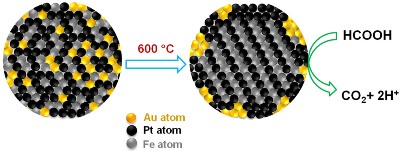A research team from the Brown University has developed a triple-headed metallic nanoparticle catalyst for fuel-cell reactions involving formic acid.
 Gold atoms create orderly places for iron and platinum atoms, then retreat to the periphery of the fuel cell, where they scrub carbon monoxide from fuel reactions. The tighter organization and cleaner reactions extend the cell's performance life. (Credit: Sun Lab/Brown University)
Gold atoms create orderly places for iron and platinum atoms, then retreat to the periphery of the fuel cell, where they scrub carbon monoxide from fuel reactions. The tighter organization and cleaner reactions extend the cell's performance life. (Credit: Sun Lab/Brown University)
In experiments carried out by the chemists, the 4-nm nanoparticle catalyst made of iron-platinum-gold (FePtAu) generated a current of 2809.9 mA/mg Pt and retained 93% of its initial mass activity, that is, 2600 mA/mg Pt after 13 hours. According to the team, the mass activity achieved by the tetragonal nanoparticle is the highest reported in all nanoparticle catalysts tested so far. The research findings have been reported in the Journal of the American Chemical Society.
Gold plays a major role in the formic-acid fuel-cell reaction. It creates additional space inside the nanoparticle sphere and on heating it diffuses and leaves the space vacant for the platinum and iron atoms to assemble themselves as uniform layers inside the nanoparticle. As a next step, gold binds to the nanoparticle assembly’s exterior surface.
Gold forms the desired four-sided crystal structure dubbed as ‘face-centered-tetragonal’ at lower temperatures in the nanoparticle assembly. The four-sided shape helps creating more ordered structure by forcing the platinum and iron atoms to occupy the designated positions inside the structure. This helps create an atomic order which makes the platinum and iron layers bind more strongly in the structure, resulting in a more stable and durable nanoparticle assembly, which is necessary for durable and high-performance catalysts. Gold also catalyzes the oxidation of carbon monoxide, thus eliminating it from the formic-acid fuel-cell reaction. This enhances the iron-platinum catalyst’s performance, as carbon monoxide normally inhibits the catalyst’ action by binding to it.
The research team noted that gold may be replaced with other metals in the nanoparticle catalyst to enhance durability and performance of the catalyst.